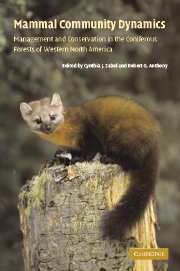 Mammal Community Dynamics
Mammal Community Dynamics Book contents
- Frontmatter
- Contents
- List of contributors
- Foreword
- Acknowledgments
- Part I Management and conservation issues for various taxa
- Part II Community and ecosystem relations
- 10 Relationships among fungi and small mammals in forested ecosystems
- 11 Ecology of coarse woody debris and its role as habitat for mammals
- 12 The ecological role of tree-dwelling mammals in western coniferous forests
- 13 The role of ungulates and large predators on plant communities and ecosystem processes in western national parks
- 14 The role of the lynx–hare cycle in boreal forest community dynamics
- 15 Associations of mammals with riparian ecosystems in Pacific Northwest forests
- Part III Conservation issues and strategies
- Index
- References
15 - Associations of mammals with riparian ecosystems in Pacific Northwest forests
Published online by Cambridge University Press: 15 December 2009
- Frontmatter
- Contents
- List of contributors
- Foreword
- Acknowledgments
- Part I Management and conservation issues for various taxa
- Part II Community and ecosystem relations
- 10 Relationships among fungi and small mammals in forested ecosystems
- 11 Ecology of coarse woody debris and its role as habitat for mammals
- 12 The ecological role of tree-dwelling mammals in western coniferous forests
- 13 The role of ungulates and large predators on plant communities and ecosystem processes in western national parks
- 14 The role of the lynx–hare cycle in boreal forest community dynamics
- 15 Associations of mammals with riparian ecosystems in Pacific Northwest forests
- Part III Conservation issues and strategies
- Index
- References
Summary
Introduction
The aquatic and terrestrial components of riparian systems provide ecological opportunities for many species of mammals. The importance of riparian habitat to wildlife populations has been documented in a wide range of habitats in North America: the midwestern United States (Stauffer and Best 1980), desert southwest (England et al. 1984), Rocky Mountains (Knopf 1985), Oregon (Anthony et al. 1987, Doyle 1990, McComb et al. 1993, Gomez and Anthony 1998, Kauffman et al. 2001), Washington (O'Connell et al. 1993, Kelsey and West 1998, Kauffman et al. 2001), and the Okanogan Highlands of British Columbia (Gyug 2000). These studies indicate that wildlife species richness is high in these ecosystems, and use of riparian zones by some species is disproportionately higher than in other areas. Although this is especially true in the more arid regions of North America (Johnson and Jones 1977, Brinson et al. 1981), this pattern can also be found in mesic forests of the Pacific Northwest. For example, Thomas et al. (1979) report that 285 of the 378 terrestrial wildlife species in the Blue Mountains of Oregon and Washington are found exclusively or more commonly in riparian areas, and Oakley et al. (1985) report similar patterns of 359 of the 414 wildlife species using riparian zones of western Washington and Oregon forests. Kauffman et al. (2001) estimate that 53% of the 593 wildlife species that occur in Washington and Oregon use riparian zones, whereas riparian zones and wetlands constitute only 1% to 2% of the landscape.
- Type
- Chapter
- Information
- Mammal Community DynamicsManagement and Conservation in the Coniferous Forests of Western North America, pp. 510 - 564Publisher: Cambridge University PressPrint publication year: 2003
References
- 14
- Cited by
